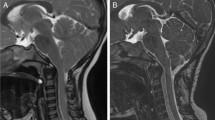Abstract
Background
Torticollis, despite being well-known neurological manifestation, is often underestimated as a first symptom of the abnormalities of posterior cranial cavity and cervical spinal cord.
Objectives
The purpose of this study is to analyze the occurrence of acquired torticollis in children as a herald sign of the tumors of the cervical spinal cord or of the posterior fossa.
Methods
Clinical records of 54 cases treated for the tumor of the cervical spinal cord or posterior fossa (including congenital ones) were retrospectively reviewed. The following data were calculated: the occurrence of the torticollis as a first sign of tumors, the duration time from the onset of the symptoms to diagnosis, the concurrence of other pathological symptoms, and the diminishing of symptoms of the torticollis following treatment.
Results
In 12/54 (22.2 %) torticollis was first sign of central nervous system tumor and in all of them preceded other neurological symptoms. The time from the onset of torticollis to establishing diagnosis ranged from 2 to 52 weeks (9.6 weeks on average). Eleven of twelve patients were treated surgically—in 10 of them, torticollis disappeared in the postoperative course.
Conclusions
Torticollis may be a herald sign of the tumor of the cervical spinal cord or the posterior fossa. Those pathologies should be considered in the differential diagnosis of the torticollis, particularly if accompanied by other symptoms of the focal pathology of central nervous system. Awareness of this fact may shorten the time to establish the proper diagnosis. Torticollis necessitates exclusion of the posterior fossa and spinal cord tumor.


Similar content being viewed by others
References
Marciniak W, Szulc A (2008) Brevicollis, Syndroma Klippel-Feil In: Wiktora Degi Ortopedia i Rehabilitacja, PZWL, Warszawa 2008, pp 55–56
Boricean ID, Bărar A (2011) Understanding ocular torticollis in children. Oftalmologia 55(1):10–26
Mutsaers P, Fick M, Plotz FB (2007) Acquired torticollis as the only initially presenting symptom in child with a brainstem glioma. Eur J Pediatr 166:1075–1076
Dorner L, Fritsch MJ, Stark AM, Mehdorn HM (2007) Posterior fossa tumors in children: how long does it take to establish the diagnosis? Childs Nerv Syst 23:887–890
Bussieres A, Cassidy JD, Dzus A (1994) Spinal cord astrocytoma presenting as torticollis and scoliosis. J Manip Physiol Ther 17(2):113–118
Drozyńska E, Połczyńska K, Bień E et al (2004) Solid tumours of the vertebral column and spinal cord in children. Reasons and consequences of diagnostic delay. Med Wieku Rozwoj 8:183–191
Shay V, Fattal-Valevski A, Beni-Adani L, Constantini S (2012) Diagnostic delay of pediatric brain tumors in Israel: a retrospective risk factor analysis. Childs Nerv Syst 28(1):93–100
Turgut M, Akalan N, Bertan V, Erbengi A, Eryilmaz M (1995) Acquired torticollis as the only presenting symptom in children with posterior fossa tumors. Childs Nerv Syst 11:86–88
Denaro L, Longo UG, Papalia R et al (2008) Eosinophilic granuloma of the pediatric cervical spine. Spine 33(24):936–941
Kiwak KJ, Deray MJ, Shields WD (1983) Torticollis in three children with syringomyelia and spinal cord tumor. Neurology 33(7):946–948
Visudhiphan P, Chiemchanya S, Somburanasin R, Dheandhanoo D (1982) Torticollis as the presenting sign in cervical spine infection and tumor. Clin Pediatr (Phila) 21(2):71–76
Kumandaş S, Per H, Gümüş H, Tucer B, Yikilmaz A, Kontaş O, Coşkun A, Kurtsoy A (2006) Torticollis secondary to posterior fossa and cervical spinal cord tumors: report of five cases and literature review. Neurosurg Rev 29:333–338
Extremera VC, Alvarez-Coca J, Rodriguez GA (2008) Torticollis is a usual symptom in posterior fossa tumors. Eur J Pediatr 167:249–250
Marmor MA, Beauchamp GR, Maddox SF (1990) Photophobia, epiphora, and torticollis: a masquerade syndrome. J Pediatr Ophthalmol Strabismus 27:202–204
Straussberg R, Harel L, Amir J (2002) Pseudotumor cerebri manifesting as stiff neck and torticollis. Pediatr Neurol 26:225–227
Author information
Authors and Affiliations
Corresponding author
Rights and permissions
About this article
Cite this article
Fąfara-Leś, A., Kwiatkowski, S., Maryńczak, L. et al. Torticollis as a first sign of posterior fossa and cervical spinal cord tumors in children. Childs Nerv Syst 30, 425–430 (2014). https://doi.org/10.1007/s00381-013-2255-9
Received:
Accepted:
Published:
Issue Date:
DOI: https://doi.org/10.1007/s00381-013-2255-9




